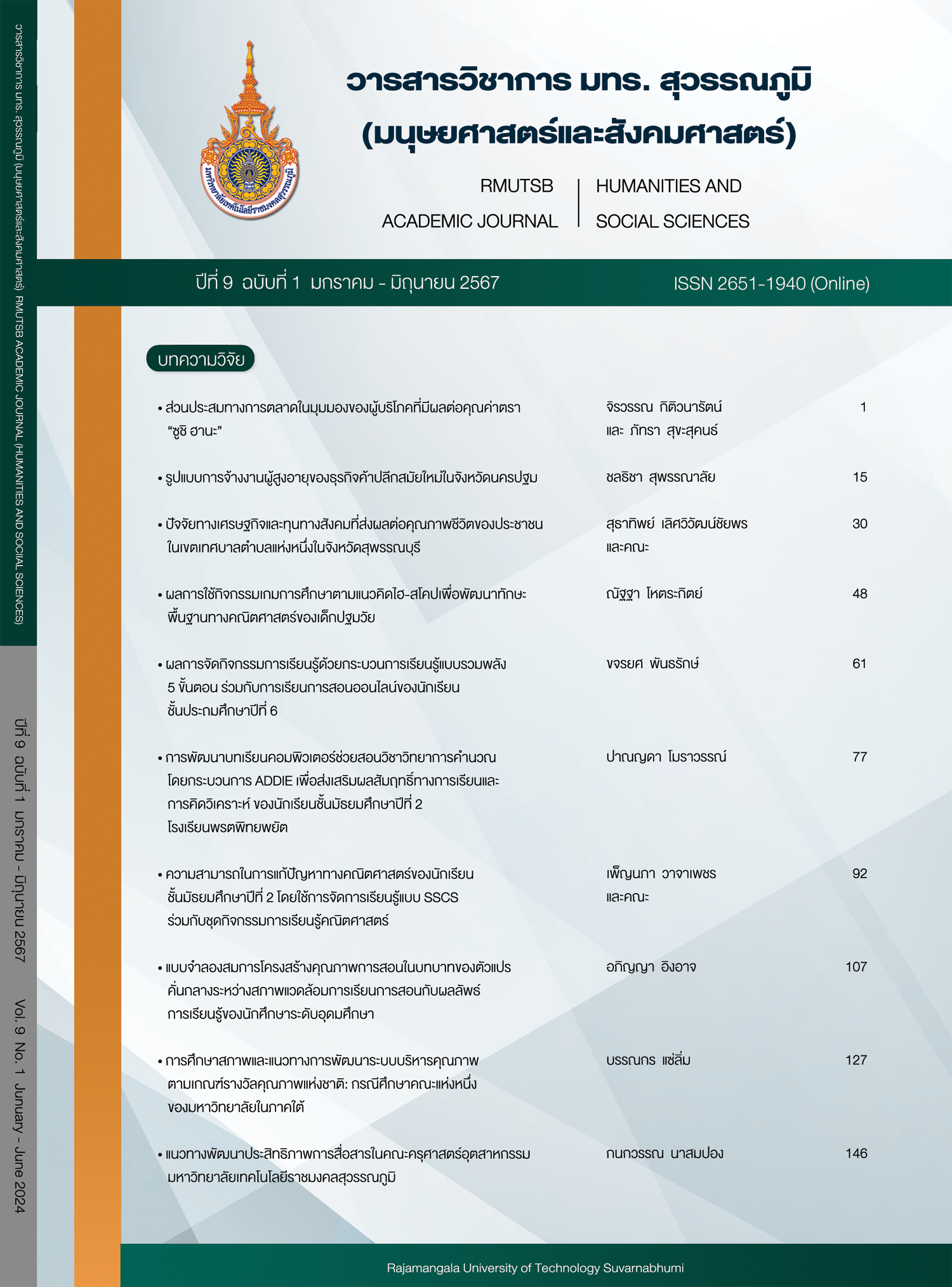The structural equation modeling of teaching quality as a mediator variable between learning environment and learning outcomes of higher education students
Main Article Content
Abstract
This research article aimed to (1) studied the teaching quality of instructors, learning outcomes, and learning environment, (2) studied the influence of the teaching quality of instructors on the intermediate role between learning environment and learning outcomes, and (3) presented procedures and solutions of structural equation model analysis. The secondary data were from 443 higher education students in the academic year 2021 who completed the assessment through the University's Educational Services (REG) system. The reliability of the assessment form was between 0.91-0.98. Data were analyzed by statistical techniques including mean, standard deviation, skewness, kurtosis and structural equation model analysis. The research results found that (1) Teaching quality of instructors and learning environment were at the most appropriate level, and the students learning outcomes were greatly improved. (2) The teaching quality of instructors was the full mediate variable between the learning environment and student learning outcomes, and the learning environment and teaching quality of the instructors explained the variance in learning outcomes at 80.00%. (3) Appropriate approaches and procedures for analyzing a specific structural equation model consisted of 6 steps: data outlier assessment, normal distribution assessment of each variable, construction of validity assessment of latent variables, discriminant validity assessment between latent variables, structural model analysis, and classification of influences. Moreover, the solution to the problem of discriminant validity between structured latent variables was to combine the structure of latent variables into a second-order construct.
Article Details

This work is licensed under a Creative Commons Attribution-NonCommercial-NoDerivatives 4.0 International License.
References
Anderson, J. C., & Gerbing, D. W. (1988). Structural equation modeling in practice: A review and recommended two-step approach. Psychological bulletin, 103(3), 411-423.
Baron, R. M., & Kenny, D. A. (1986). The moderator–mediator variable distinction in social psychological research: Conceptual, strategic, and statistical considerations. Journal of Personality and Social Psychology, 51(6), 1173.
Browne, M. W., & Cudeck, R. (1993). Alternative ways of assessing model fit. In K. A. Bollen, & J. S. Long (Eds.), Testing structural equation models (pp. 136-162). Newbury Park, CA: Sage.
Farrell, A. M. (2010). Insufficient discriminant validity: A comment on Bove, Pervan, Beatty, and Shiu (2009). Journal of Business Research, 63(3), 324-327.
Fornell, C., & Larcker, D. F. (1981). Evaluating structural equation models with unobservable variables and measurement error. Journal of Marketing Research, 18(1), 39-50.
Hair, J. F., Black, W. C., Babin, B. J., & Anderson, R. E. (2010). Multivariate data analysis (7th ed.). New York, NY: Pearson.
Hayes, A. F. (2009). Beyond Baron and Kenny: Statistical mediation analysis in the new millennium. Communication monographs, 76(4), 408-420.
Hu, L. T., & Bentler, P. M. (1999) Cutoff Criteria for fit indexes in covariance structure analysis: Conventional criteria versus new alternatives. Structural Equation Modeling, 6(1), 1-55.
Iamkhongsi, S. (2018). Classroom management in the 21th Century. Bangkok: Triple education. (in Thai)
Ingard, A. (2022). Principles theories and practices: structural equation modeling. Bangkok: Chulalongkorn University Press. (in Thai)
Jöreskog, K. G. (1971). Simultaneous factor analysis in several populations. Psychometrika, 36(4), 409-426.
Kline, R. B. (1998). Principles and practice of structural equation modeling. New York, NY: The Guilford Press.
Mulaik, S. A., & Millsap, R. E. (2000). Doing the four-step right. Structural Equation Modeling, 7(1), 36-73.
Nunnally, J. C. (1978). Psychometric theory (2nded.). New York, NY: McGraw-Hill.
Office of the Education Council. (2017). National education plan. Bangkok: Prig Whan Graftfic. (in Thai)
Ongardwanich, N. (2016). 21st century skills assessment guidelines. Journal of Education Thaksin University, 16(2), 1-11. (in Thai)
Panich, W. (2012). Ways to create learning for students in the 21st century. Bangkok: Tathata Publication. (in Thai)
Phra Kru Baidika Monthon Khamago (Chutosri). (2019). Environmental influence of contributing learning for development of tertiary students. Journal of Yanasangvorn Research Institute Mahamakut Buddhist University, 10(1), 192-200. (in Thai)
Henseler, J., Ringle, C., & Sarstedt, M. (2015). A new criterion for assessing discriminant validity in variance-based structural equation modeling. Journal of the Academy of Marketing Science, 43, 115-135.
Schumacker, R. E., & Lomax, R. G. (2004). A beginner's guide to structural equation modeling (2nded.). Mahwah, NJ: Lawrence Erlbaum Associates.


